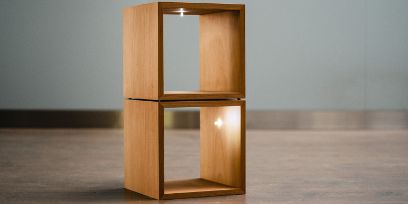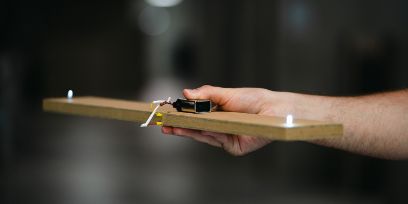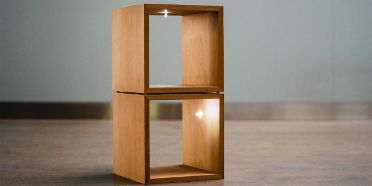- Press Release
Researchers develop conductive furniture panels
13.10.2022 Lighting solution integrated into furniture panels could become cableless: a wood-based panel that conducts electricity has been developed by researchers at the Institute for Materials and Wood Technology IWH at Bern University of Applied Sciences BFH. The product will now be taken to market-launch stage in a next step.
Imagine a piece of furniture with integrated lighting but no complex cabling – well that’s now been made possible by a special wood-based panel conducting electricity developed by researchers at the Institute for Materials and Wood Technology IWH at Bern University of Applied Sciences BFH under the leadership of Heiko Thömen. The secret element: inside the panel are two thin layers containing a small amount of carbon fibre through which electricity can flow. In an initial interdisciplinary concept study – carried out together with the Architecture Division and BFH’s School of Engineering and Computer Science – researchers succeeded in developing a low-current, conductive wood-based panel in 2019. As part of the follow-up feasibility study, the panel underwent further development and improvement to produce a fully functioning prototype based on the design of Charles Job at the Architecture Division.
Improved conductivity and workability
After the successful concept study, researchers focused on making improvements in various areas during the feasibility study. Firstly, the process for mixing wood and carbon fibre had to be optimized. Instead of the previous method of mixing the fibres when dry, the researchers tested a procedure where the fibres were mixed in water and then allowed to dry. This method enables much more homogeneous mixing which has a positive impact on conductibility while also significantly reducing the amount of carbon fibre.
Ensuring good workability of the panels was another major challenge and is a key criterion for wood panels used in furniture manufacturing. The research team resolved this issue by modifying the panel’s structure. The panel previously consisted of three layers: two conductive layers made of the carbon-wood mix and a conventional middle layer acting as an insulator between them. The optimised panel consists of five layers where the two external layers are similar to the surface of conventional wood-based materials which means they can be coated with veneer or laminate. By optimising the mixing process and panel structure, the amount of carbon fibre was reduced to below 1 percent in relation to the wood mass.
Next step: taking the panel to market-launch stage
The researchers have now filed a patent application for the low-current conductive furniture panels. A recycling concept has also been produced. The product will now be taken to market-launch stage in a next step. The researchers are now looking for a partner to implement the project. Initial discussions with potential partners in Switzerland and abroad have already been held.


